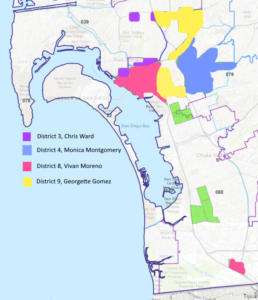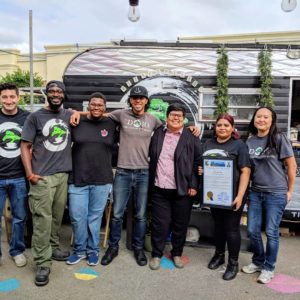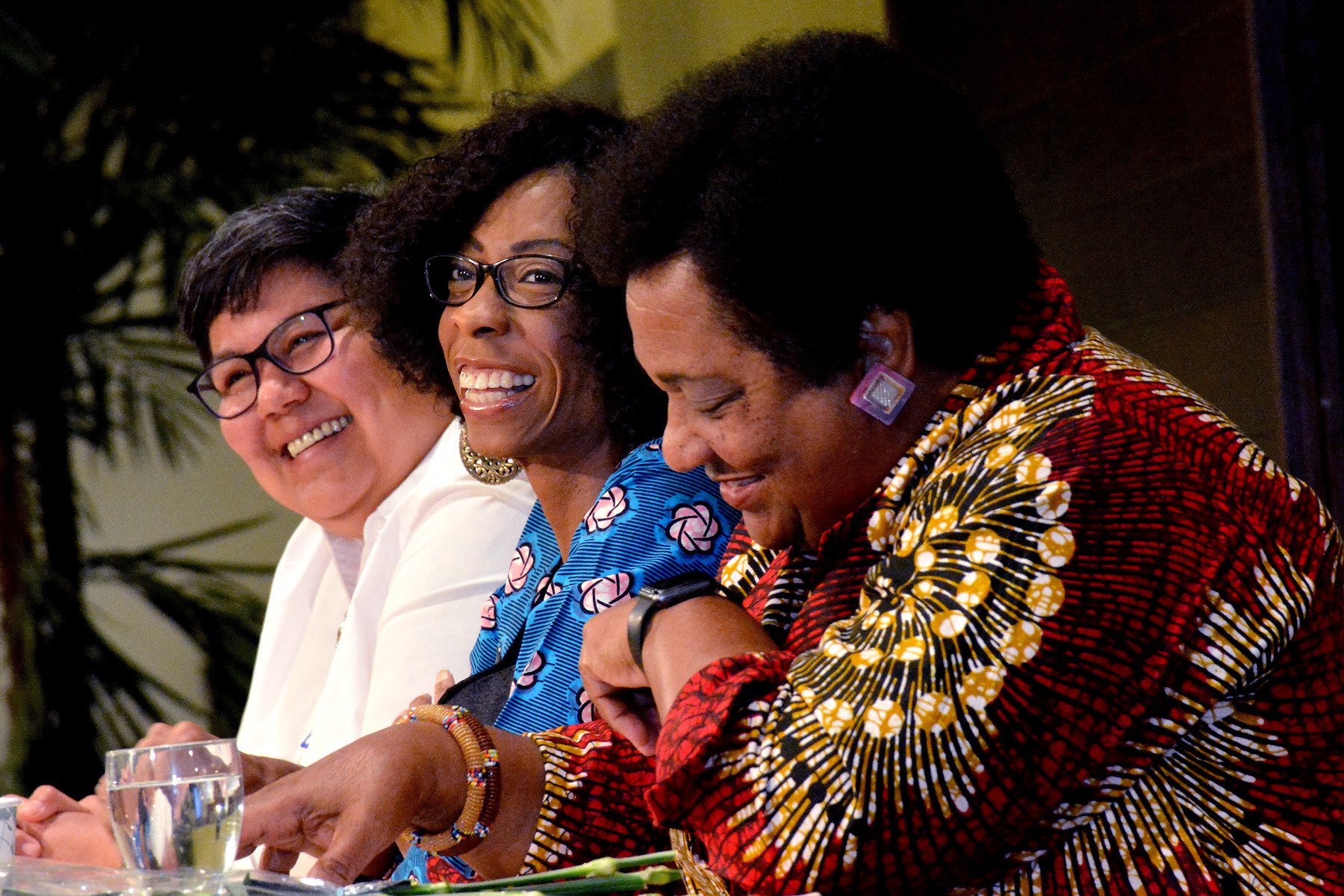On the first Saturday of this month, Black History Month, I had the privilege of joining Indivisible WATU for their annual Women of Color Roar breakfast celebrating, encouraging, and empowering each other to step into leadership and public service. With a panel of powerhouse elected officials, and more seated in front of them, for many high school attendees this was the first time they shared a room with the people who represent them in office. For those of us who’ve been to (too) many a luncheon with elected officials, we could feel a marked change in the energy of our public officials, one that filled me with optimism.
California State Assemblymember Dr. Shirley Weber, San Diego City Council President Georgette Gómez, and newly elected San Diego City Councilmember Monica Montgomery shared extremely candid remarks–both prepared and off the cuff–demonstrating these women understand the needs of their constituents at a deep, human level.
Standing up for and getting involved in causes we care about, whether it’s the books included on our grade school curriculum or community choice energy, teaches both what it means to fight for an idea and how to build enthusiasm, momentum, and coalitions for change. All three of the esteemed panelists agitated for change at low stakes levels before tackling greater and greater issues. This authentic experience built trust with their constituents. As Monica put it, our voters are demanding that their elected officials actually reflect, connect with, and understand their communities.
Creating local government that is equitable, inclusive, transparent, & accountable can’t be done alone. It takes having others who share these values alongside you. Talking this morning about how to run, win, & make real change for our communities. #WOCRun2Win#WOCRoar #WOC_Roar pic.twitter.com/N9UTXosnuI
— CP Georgette Gómez (@GGomezD9) February 2, 2019
What does this have to do with Opportunity Zones?
The biggest concern I have for Opportunity Zone investing is the disconnect between high net worth investors and the low-income residents in Qualified Opportunity Zones. The drive to limit investors’ tax exposure is not necessarily aligned with the original intention of the legislation: lifting up low-income communities. Opportunity Zones have the potential for the biggest wave of gentrification and displacement we’ve ever seen. However, after the Women of Color Roar breakfast and several other community meetings this month, I’m optimistic about San Diego.  Reflecting after breakfast, I realized that these women–Georgette Gómez, Monica Montgomery, and Dr. Shirley Weber, along with California State Assemblymember Lorena Gonzalez and San Diego City Councilmember Vivian Moreno represent most of San Diego County’s largest Qualified Opportunity Zones. This large zone stretches from Barrio Logan along Imperial Avenue and the 94 highway to the Diamond District, and up into City Heights. A lot has been written by folks way more politically plugged in than me, but it’s worth noting that San Diego politics are changing rapidly. This will affect local community plans, zoning regulations, and government pressure on banks and investors–key components for Opportunity Zone investing.
Reflecting after breakfast, I realized that these women–Georgette Gómez, Monica Montgomery, and Dr. Shirley Weber, along with California State Assemblymember Lorena Gonzalez and San Diego City Councilmember Vivian Moreno represent most of San Diego County’s largest Qualified Opportunity Zones. This large zone stretches from Barrio Logan along Imperial Avenue and the 94 highway to the Diamond District, and up into City Heights. A lot has been written by folks way more politically plugged in than me, but it’s worth noting that San Diego politics are changing rapidly. This will affect local community plans, zoning regulations, and government pressure on banks and investors–key components for Opportunity Zone investing.
What has changed?
San Diego City Council is now 6/9 Democrat and 5/9 women. Of note, Monica (D4) & Vivian (D8) won their district races without most of the conventional capital from the Democratic party & labor unions, but instead through grassroots campaigns steeped in community participation and deep listening to their constituents. Likewise, our city leadership in Georgette Gómez (D9)–unanimously chosen by her peers to be City Council President—is a significant change.
- Before running for office, Georgette was the associate director at the Environmental Health Coalition, cutting her teeth on asset-based community development and collaborative approaches to change.
- In addition to being City Council President, she now chairs the MTS transportation board and serves on the executive committee of SANDAG. These broader positions point to the potential for inclusive transit-oriented development in our low-income communities, including Opportunity Zones, decreasing displacement effects and increasing income mobility.
- You can often catch Georgette and her team at our beloved Fair@44 reactivated lot in City Heights [visit the DOJO Cafe!], not just at their office at City Hall. She even hosted her most recent State of the District there where residents could easily arrive by bus, foot, bikeshare, or car.
 Finally, regardless of how you feel about her, there is no denying that California State Assemblymember Lorena Gonzales is a dynamo. With the election of her husband Nathan Fletcher as the first Democrat on the San Diego County Board of Supervisors in nearly 30 years, changes are already underfoot. Their household’s capacity to foment change at the State, County, and local levels is unrivaled. Taken together, we have a new political landscape that is more representative of and responsive to the variety of voters who live here.
Finally, regardless of how you feel about her, there is no denying that California State Assemblymember Lorena Gonzales is a dynamo. With the election of her husband Nathan Fletcher as the first Democrat on the San Diego County Board of Supervisors in nearly 30 years, changes are already underfoot. Their household’s capacity to foment change at the State, County, and local levels is unrivaled. Taken together, we have a new political landscape that is more representative of and responsive to the variety of voters who live here.
More Community Supports: City-County Reinvestment Taskforce & San Diego Promise Zone
Monica and Nathan are the new co-chairs of the joint City-County Reinvestment Taskforce, another exciting shift. I joined their meeting last week centered on Promise Zone & Opportunity Zone updates. I am happy to share that the right questions were being asked to ensure sensitive community investing, and to minimize displacement through Opportunity Zone investing. Some highlights of what’s emerging in our local ecosystem:
- Community-based organizations and elected officials have a hearty appetite to distill Opportunity Zones into plain English, then translate into Spanish, Vietnamese, Tagalog, Ilokano, Somali, and other key languages spoken in these census tracts.
- The City of San Diego Economic Development Department, Community Development Division is working on a unified portal with a map of investable parcels and businesses.
- Those of us with impact-first investment strategies (Mission Driven Finance and our colleagues at LISC, City Heights CDC, and Civic San Diego) are openly collaborating to leverage each other’s strengths for the benefit of the community.
- We are working with organizations with a long history of stakeholder engagement to ensure local voices are heard throughout investment planning and implementation. This also will help elevate high-impact dealflow that may not otherwise make it to investors’ radar screens.
- Promise Zone community engagement – The San Diego Promise Zone has been convening a broad cross-section of stakeholders for nearly three years to strengthen collaborative proposals for Federal funding and ultimately create a safer, more vibrant set of neighborhoods. The surveys and resident organizing that they’ve already undertaken significantly accelerate the timeline to understanding and investing in these communities.
The political and community machinery is moving, and in such a way that is responsive to local resident stakeholders’ needs. Because of this building momentum, we’re optimistic about being able to create lasting community benefit in San Diego’s Opportunity Zones. 
For further reading:
- FuseCorps—Avoiding Gentrification: How to Use Opportunity Zones to Benefit Communities
Update on the disconnect between investors & community:
As heard at #DCOppZones:
There are 20 funds that have launched w targeted capital raises of $1B+. They’re having a hard time calling $ bc they can’t find deals. They can’t find deals bc they aren’t working w and embedded in the community. (that’s real…) #OpportunityZones — Rachel Reilly (@Rachel__Reilly) February 26, 2019
Deploying $ into communities when you lack market expertise + local partners.
Difficult to:
1) Find deals
2) Evaluate & mitigate risk (or perceived risk)
3) Asset management
Private market wasn’t investing in these places prior.
Need local buy-in to be successful long term.
— Rachel Reilly (@Rachel__Reilly) February 26, 2019


